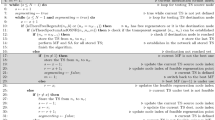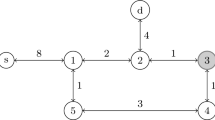Abstract
In this paper we study translucent optical networks as an alternative to fully transparent and fully opaque optical networks. In the former networks, a technique called sparse placement is used to overcome the lightpath blocking caused by the signal quality degradation, using much less regenerators, which must strategically be placed, in contrast to a fully opaque network. In this paper we propose a sparse placement algorithm based on two requirements. The first one is signal regeneration necessary to re-amplify, reshape, and retime the optical signals after some predefined transparent distance in order to successfully receive the signals at the destination node. The other is load balance of the traffic in the network aimed at efficient usage of the network capacity resources. We apply a distributed Dijkstra routing algorithm which dynamically changes weights of links during the process of locating regeneration capable nodes. We compare the performance of the proposed algorithm with commonly used sparse placement algorithms through simulation experiments. The benefits are such that load balancing of the network traffic is fully utilized, and with technological development it will be sufficient to equip up to 30% of nodes in the network with electronic regenerations in order to have the same performance as in an opaque network.
Similar content being viewed by others
References
Shen G., Tucker R.S.: Translucent optical networks: the way forward. IEEE Commun. Mag. 45(2), 48–54 (2007) doi:10.1109/MCOM.2007.313394
Yang X., Ramamurthy B.: Sparse regeneration in translucent wavelength-routed optical networks: architecture, network design and wavelength routing. Photon. Netw. Commun. 10(1), 39–53 (2005) doi:10.1007/s11107-005-1694-y
Shen G., Grover W., Cheng T., Bose S.: Sparse placement of electronic switching nodes for low blocking in translucent optical networks. J. Opt. Netw. 1(12), 424–441 (2002)
Peng Y., Hu W., Sun W., Wang X., Jin Y.: Impairment constraint multicasting in translucent WDM networks: architecture, network design and multicasting routing. Photon. Netw. Commun. 13(1), 93–102 (2007) doi:10.1007/s11107-006-0018-1
Ye Y., Cheng T.H., Lu C.: Routing and wavelength assignment algorithms for translucent optical networks. Opt. Commun. 229(1–6), 233–239 (2004)
Ramamurthy, B., Datta, D., Feng, H., Heritage, J.P., Mukherjee, B.: Transparent vs. opaque vs. translucent wavelength-routed optical networks. In: Optical Fiber Communication Conference 1999, vol. 26 of OSA Proceedings Series, pp. 59–61. Optical Society of America, Washington, D.C. (1999)
Ramamurthy, B., Yaragorla, S., Yang, X.: Translucent optical WDM networks for the next-generation backbone networks. In: Proceedings of IEEE GLOBECOM, vol. 1, pp. 60–64, San Antonio, TX, November 2001
Singh P., Sharm A.K., Rani S.: Routing and wavelength assignment strategies in optical networks. Opt. Fiber Technol. 13(3), 191–197 (2007) doi:10.1016/j.yofte.2006.10.002
Ye Y., Chai T., Cheng T., Lu C.: Algorithms for the design of WDM translucent optical networks. Opt. Express 11(22), 2917–2926 (2003)
Yang X., Ramamurthy B.: Dynamic routing in translucent WDM optical networks. IEEE Int. Conf. Commun. 5, 2796–2802 (2002)
Yang, X., Ramamurthy, B.: Sparse regeneration in a translucent WDM optical network. In: Proceedings of the SPIE Asia-Pacific Optical and Wireless Communications, pp. 61–70, Beijing, China, November 2001
Yang X., Ramamurthy B.: Interdomain dynamic wavelength routing in the next-generation translucent optical Internet. J. Opt. Netw. 3(3), 169–187 (2004) doi:10.1364/JON.3.000169
Ali M., Ramamurthy B., Deogun J.S.: Routing and wavelength assignment with power considerations in optical networks. Computer Netw. 32(5), 539–555 (2000) doi:10.1016/S1389-1286(00)00015-3
Tintor V., Matavulj P., Radunović J.: Analysis of blocking probability in optical burst switched networks. Photon. Netw. Commun. 15(3), 227–236 (2008) doi:10.1007/s11107-007-0101-2
Medhi D., Ramasamy K.: Network Routing: Algorithms, Protocols, and Architectures. Morgan Kaufmann, San Francisco (2007)
Yaragorla, S.: Sparse regeneration in a translucent wide area optical network. Master Thesis, University of Nebraska-Lincoln, Lincoln, May (2000)
Mukherjee B.: Optical WDM Networks. Springer, New York (2006)
Author information
Authors and Affiliations
Corresponding author
Rights and permissions
About this article
Cite this article
Tintor, V., Radunović, J. Distributed Dijkstra sparse placement routing algorithm for translucent optical networks. Photon Netw Commun 18, 55–64 (2009). https://doi.org/10.1007/s11107-008-0170-x
Received:
Accepted:
Published:
Issue Date:
DOI: https://doi.org/10.1007/s11107-008-0170-x




